








The City of Greater Geraldton would like to respectfully acknowledge the Yamatji Peoples who are the Traditional Owners and First Nation’s People of the land on which we stand. The Wilunyu, Nhanhagardi, Naaguja. We would like to pay our respect to the Elders past, present and future for they hold the memories, the traditions, the culture and hopes of the Yamatji Peoples.
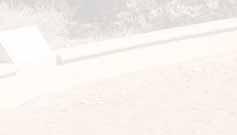
Artwork credit: ‘Ilgarijiri: things belonging to the sky’, Barbara Merritt, Margaret Whitehurst and Mary Stuart (UAP).





I am proud to present the City of Greater Geraldton Public Art Masterplan (20252030). This document provides a plan for delivery of public art across the City and reflects Council’s ongoing commitment to the enrichment of public spaces and places through artistic activity.
The Masterplan takes into account the care and maintenance of the City’s existing, extensive public art collection, along with opportunities for new works which respond to community aspiration, storytelling and interpretation. In this context, the Masterplan considers works installed in spaces that are a public asset and are managed by/or are intended to be managed by Council.
Following the endorsement of the City’s Public Art Strategy (2020-2025), the Masterplan has been developed to grow and consolidate the public art program administered by Council. In doing so, the Geraldton Regional Art Advisory Committee– a group consisting of elected members, community representatives and City officers, is acknowledged for their valued input. It is exciting to see our thriving arts and cultural sector continue to be supported through the framework this Masterplan provides.
I would like to thank all the stakeholders, both internal and external, for their input and knowledge in bringing this important document together. We look forward to celebrating the outcomes and actions in our community.






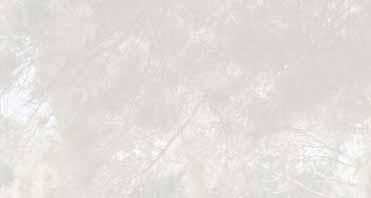
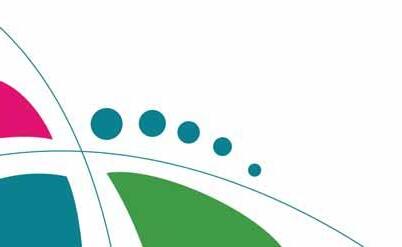
The City of Greater Geraldton is home to an extensive collection of public artworks, ranging from functional and integrated artworks to iconic commissions. Until the development of the Public Art Strategy 2020-2025, the City’s collection had grown organically, with works and programs delivered in response to short term needs and goals. With the opportunity to revisit the Strategy comes the potential to leverage and reposition the existing collection. The new Masterplan has been developed to incorporate learnings from the former Strategy and to undertake a long-term approach in order to consolidate, maintain and ultimately grow a cohesive collection of public art. The Masterplan acknowledges the diverse context of the City, including a broad range of themes which seek to articulate the history and identity of the community.
In addition to improving the amenity and aesthetics of the public realm, the community art element of the City’s Public Art program provides economic and professional development opportunities for local artists. The document provides practical guidance for Officers with regard to procurement processes, condition monitoring and maintenance.


This Masterplan has been informed by the following City of Greater Geraldton (CGG) documents.
Greater Geraldton 2031: Strategic Community Plan
The CGG Public Art Strategy 2020-2025 supports the Strategic Community Plan’s Vision, Mission and Values. The Strategy and this accompanying Public Art Masterplan to guide implementation respond directly to the following major goals:
Aspiration: Our culture and heritage is recognised and celebrated. We are creative and resilient. We can all reach our potential.
1.1 Enhanced lifestyle through spaces, places, programs and services that foster connection and inclusion.
1.3 Pride in place and a sense of belonging is commonplace.
1.7 Reconciliation between Indigenous and non-indigenous communities is supported.
1.10 A place where people have access to, engage in and celebrate arts, culture, education and heritage.
Economy: A healthy thriving and resilient economy that provides opportunities for all whilst protecting the environment and enhancing our social and cultural fabric.
2.4 A desirable place to live, work, play, study, invest and visit.
CGG Public Art Strategy 2020-2025; Geraldton City Centre Revitalisation Plan; CGG Heritage Strategy 2023-2028; CGG Reconciliation Action Plan 2024-2026; CGG Youth Strategy 2024-2029; CGG Council Policy CP1.4 Access and Inclusion; CGG Access and Inclusion Plan 2024-2029; CGG Council Policy CP4.9 Procurement of Goods and Services; CGG Operational Policy OP017 Geraldton Regional Art Gallery Collection. s

Public art includes both permanent and ephemeral art installation and activities, integrating an artistic concept into a public feature. Public art is planned and executed outside a gallery context in spaces which are generally open and accessible to all. Practitioners may range from the beginner to the professional artist. Professional artists may have a tertiary qualification in visual arts, have experience exhibiting and selling their work to collecting bodies and be represented in major public collections. Public art can become an iconic part of a town, place, or even country! Local communities take pride in artworks that become icons, and tourism can increase through these artworks becoming attractions.
1. Murals/Street Art

• Artist-led, may contain community elements, semi-permanent on exposed walls and infrastructure.
2. Freestanding/Sculptural
• Standalone work, fabricated by the artist or externally.
3. Integrated/Placemaking
• Part of a development, incorporated into the design of a building or infrastructure, Wayfinding or interpretive communication, Functional.
4. Ephemeral
• Work designed to be temporary, have a limited life-span.
5. Play-friendly
• Kinetic, bright work appeals to a sensory experience.
6. Cultural Heritage/Commemorative Art
• Artwork that has cultural importance to a specific group or that celebrates people, an activity or significant event.




• Features of a building and enhancements such as screens and lighting
• Integrating into public spaces through creative street furniture, artistic paving and works that improve the overall quality
• Mural work that covers walls, floors and walkways
• Tiles, mosaics and brick work that can integrate into developments or standalone
• Sculptural work that incorporates durable and damage resistant materials, as well as following safety standards
• Community art projects led by a professional artist that result in a tangible artwork in a range of ephemeral and permanent w
works


• Business logos and advertising signage
• Art objects which are mass produced or off-the-shelf reproductions, not providing a unique response to the local area
• Fencing, gates, benches and other functional items that do not contribute to the artistic character of the local area
• Landscaping or hardscaping which would normally be associated with developments y of an n area
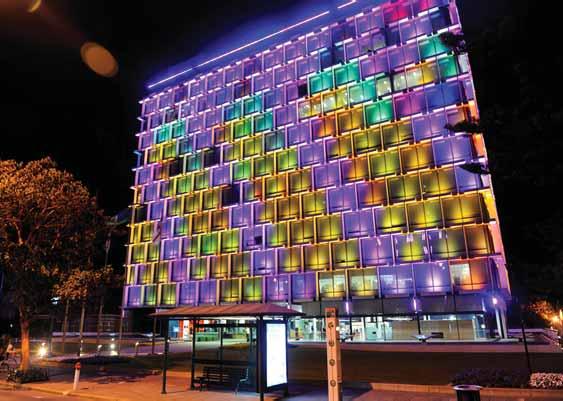


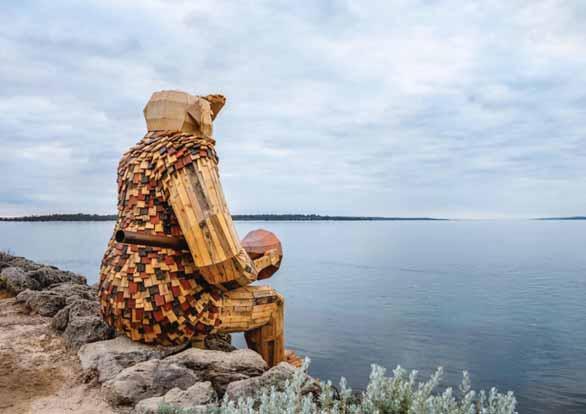
ARTWORKS clockwise from top left: COUNCIL HOUSE
Perth, WA. Trevor Richards REFLECTIONS
Wellington Dam, Collie WA. Guido Van Helten GIANTS OF MANDURAH Mandurah, WA. Thomas Dambo
GROW YOUR OWN
Perth, WA. James Angus



clockwise from top left: CLOUD GATE
Chicago, Illinois. Sir Anish Kapoor
ANGEL OF THE NORTH
Newcastle, UK. Antony Gormley
PUPPY
Bilbao, Spain. Jeff Koons
JACOB’S LADDER
North Island, New Zealand. Gerry Judah


The City of Greater Geraldton is a vibrant City, with a diverse collection of registered public artworks across the region. The City has a Public Art Team, located in the Geraldton Regional Art Gallery, and the Geraldton Regional Art Advisory Committee that provides valuable input from community members.
Within a thriving arts community, public art provides new and exciting opportunities for emerging and established creatives. Professional development and small to medium sized projects aimed at local artists may include commissions that are City, Agency/Developer or Community/Artist driven. First Nations Led artwork must be driven by First Nations peoples as the creators, decision-makers and custodians of the artwork designs.
Opportunities for larger public art projects that are open to all artists may harness partnerships and funding opportunities outside the City of Greater Geraldton, elevating the local art scene and creating iconic artworks for the community. Having a mixture of external and local artists creates a strong Public Art Collection featuring a variety of mediums, subject matter and storytelling. This is turn contributes to the creation of safe, accessible public spaces, promoting community identity and recognising diversity.
Currently, the Public Art Collection features works by Edmund Stewart, Tony Jones, Charmaine Green, Helen Ansell, and Trevor Richards to name a few. With over 200 artworks, this includes commissioned work, direct-approaching, school projects, large installations, and a wide variet y of murals.



Dutch ships sailed past the Western Australian coast in the 17th Century with landings including those which took place at the explorer to set foot on land was Lieutenant George Grey, a member of the British Army, in 1839. Geraldton’s offi 1849, when a prospecting party and soldiers arrived at Champion Bay and began settlement. Champion Bay developed as a port wit and later horses. Discovery of gold in the Murchison in the 1890s and construction of rail lines soon led to the spread of set contributing significantly to the growth of population and infrastructure. Over time the region continued to expand, with further diversity in agriculture, mining, construction and service industries, fishing and aquaculture and tourism. The City has a population of over 41,000 residents, encompassing the coastal City of Geraldton, along the rural townships of Mullewa, Greenough and Walkaway.
ch took place at the Abrolhos Islands. The first official settlement occurred on the 20 November y with the export of lead, wool he settlement, with pastoralism also

From the rich waters of Jambinbiri (Champion Bay) to the outer hinterland, the Midwest region has been the home for Yamatji people for tens of thousands of years. Yamatji (or Yamaji) is the name used to identify Aboriginal people in the Midwest, Murchison and Gascoyne regions of Western Australia. ‘Yamatji’ comes from the Wadjarri (or Wajarri) language and means ‘man’ or ‘human being’, so it is often used throughout this region to refer to ‘Aboriginal people/ person’. The Yamatji region in Western Australia contains many Aboriginal groupings. Approximately 10% of the total population of the region are Yamatji people, who live mostly in Geraldton and Carnarvon. The City of Greater Geraldton proudly celebrates Yamatji People and culture through the Yamatji Drive Trail, highlighting significant sites across the City.




This Public Art Masterplan seeks to guide public art projects in the City of Greater Geraldton, providing a framework for new projects that are aligned with the overarching vision for art in the public realm.
This Masterplan will integrate with the City of Greater Geraldton Public Art Strategy, working in conjunction to inform new public art projects and future direction for art in the City.
This Public Art Masterplan has been developed in consultation with the Geraldton Regional Art Advisory Committee. The Committee comprises representatives from Council, the Community, an Aboriginal Arts organisation and City Officers.
Artwork credit: ‘Horizon’, Lucy Humphrey.
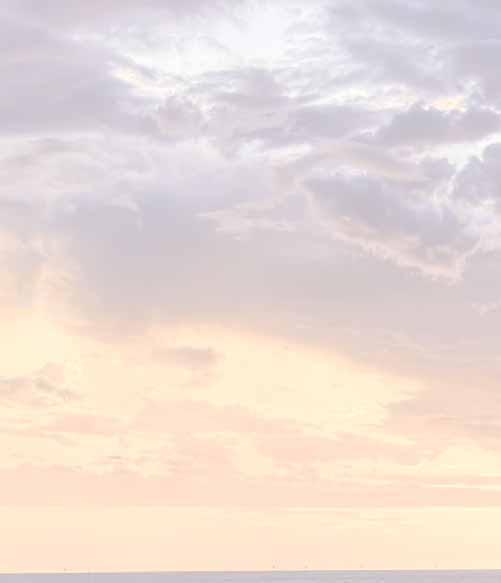
Guiding Principles
• Quality
• Inclusion
Supporting Principles
• Truth-telling
• Value history & culture
• Support local


• The artwork must be original, responding to the unique criteria of each project
• Artists with different experience levels should be matched to the requirements of the project. An artist with more experience may be more appropriate for large, iconic pieces
• The artwork should further enhance the City of Greater Geraldton’s image, building on its visual appearance and character
• The work should respond to the location, making it site specific and unique to that area
• The use of cultural materials, including stories and themes, include consent from any communities represented
• Both practical and contextual appropriateness considered, this includes a general fit-for-purpose assessment
• Suitability and ability to work within the City of Greater Geraldton Public Art Collection
• The proposed project will incorporate materials that are appropriate for outdoor conditions, unless this is an internal artwork that is not affected by outdoor conditions
• The artwork must be safe for public display
• There should be minimal maintenance required, ensuring works are durable in the unique environmental conditions
• Proposed budgets should be detailed and accurate to the project
• Artists should be paid appropriately and follow industry standards for any workshops and community engagements
• The timeline should consider whether any community consultation or engagement is required, and incorporate this into the overall project timeline

uld be detailed and accurate to the projec t unit y engagements nsider any community or d, projec t
The Geraldton Regional Arts Advisory Committee (GRAAC) provides valuable industry expertise, having an active role in encouraging and promoting the Visual Arts. The GRAAC is a Committee of Council and at the time of creation of this Masterplan serves to 2030 or as determined by Council.
The role of the GRAAC is to provide Council with support and guidance with the implementation of the Geraldton Regional Art Gallery Strategic Plan and the Public Art Strategy/Masterplan. The GRAAC supports and promotes the Geraldton Regional Art Gallery’s purpose statement which is:
To deliver high quality, responsive and targeted collection management and arts programmes which grow and enhance City and regional cultural assets, enrich people’s lives, provide economic opportunity, growth of local identity and encourage wellbeing and active participation in regional Western Australia.
Whilst not operational in nature, areas of advice may include (but not limited to) the following areas:
• Acquisition and donation of Public Art
• Relocation or deaccession of artworks
• Commissioning of new artworks
• Strategic development


The following are different types of acquisition in the procurement of new public artworks:
• Artists may be directly approached where appropriate. This is often used within the context of small public art projects and allows a particular artist to be approached for a specific project.
• A small selection of artists may be approached to submit a proposal that responds to an artist brief. This may provide a variety of options from artists identified as being appropriate for the project.
• An Expression of Interest (EOI) is circulated broadly and open to all artists (location may be limited).
• Responses to the artist brief are shortlisted, with those artists/artist teams invited to submit a concept design.
• Once presented, the successful artist is selected through a selection process.
• This may include concept designs presented to the GRAAC to be evaluated against a set of criteria, as well as through consultation with the Director/Executive Management Team/Council for final approval.
• The successful artist will be required to enter into a formal agreement with the City that will include:
» Works will be required to be completed in accordance with the industry standard and adhere to City approved safety procedures
» Maintenance schedule or requirements, including materials
» Anticipated life span of the artwork
» Intellectual Property
» Clear payment terms, including details of any phased payments

• The Brief must include location, budget, timeline, themes to respond to, and connection to policy (Public Art Masterplan and Public Art Strategy).
• The Brief must also inform the evaluation process, including weighting and timelines. Fees offered should reflect fair pay for work undertaken. An important reference source for this is the fee structure recommended by the National Association for the Visual Arts (NAVA).
• Unless direct approaching, publicise the Expression of Interest opportunity to artists, which are then collated and shortlisted.
• City staff to shortlist between three and five EOI’s where possible.
• Concepts must include the artist CV, details of scale, materials, installation methods, timelines, any engineering and safety certifications necessary, along with details of any insurance requirements.
• Concepts are evaluated by at least two GRAAC representatives against a set weighting criteria.
• Through consultation with the Director, the results of this evaluation are forwarded to the Executive Management Team for approval and direction on reporting to Council.
• Commissioning takes place on signing of an Artist Agreement by both parties.
• City approved safety procedures must be followed in the installation and fabrication of artworks.
• Following inspection and handover, the artist is required to provide the City with any specific maintenance instructions relating to the work.
• Other steps to be taken include the creation of a didactic plaque and for the work to be accessioned into the City’s.






Once a concept design is chosen and the artist/artist group is successful, the assessment panel have the opportunity to provide feedback.
At this stage, the artist may get more details on the site and project, and an update to installation timeframes if these have shifted.
The artist will then further develop their design based on this feedback and any additional briefings.
Curatorial themes identified in the Public Art Strategy 2020-2025 provided overarching direction for artists creating specific site works, as per the following graphic taken from the Strategy, page 11. Geographic areas were identified as:
• Stories of the City (Geraldton City Centre)
• The Threshold (Coastline from South Greenough to Drummond Cove, including Greenough and Walkaway)
• The Hinterland (Mullewa and inland areas)
These themes are intended to provide a starting point for public art projects and ensure that new artworks in the City of Greater Geraldton are strong investments, led by relevant and unique attributes that uphold the environmental, social and heritage values of the City.
Curatorial themes are to provide overarching direction for artists creating site specific works. Artists are encouraged to use these themes for inspiration and to instigate further research into the stories of the region. Further information on specific stories for Mullewa, Greenough, Walkaway and Geraldton can be found in the City Municipal Inventory of Heritage Places.
The City of Greater Geraldton is a place of distinct stories and narratives. Mapping these across the region reveals an interrelated web of themes, characters and connections; Indigenous, exploration, pastoral, agriculture, mining, and maritime.
These stories create connections between the main activity centres.












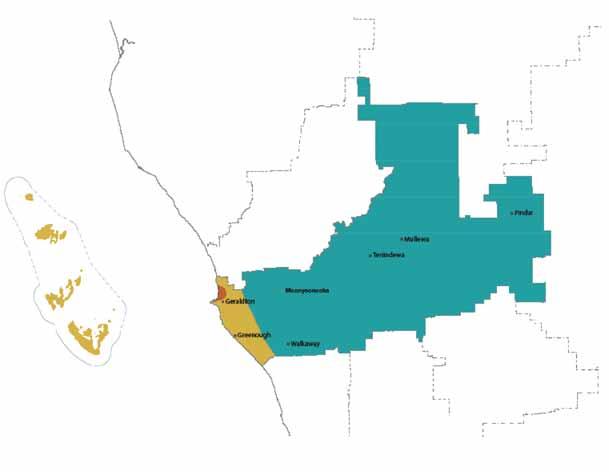


Theme
The City is for coming together, sharing stories, discovering traditions, and making new memories, all set against the backdrop of port and maritime operations.
Simultaneously a place for first experiences of the country, it is the home of farewells and distant horizons.
• Ancestry
• Indigenous significance
• Early settlement
• Fishing, connecting the sea to land
• Contemporary pastimes/leisure
• Cultural conflicts
• Significant sites for Yamatji People
Geraldton is a place of ever-changing perceptions, contrasting against enduring memories and age-old tales.
Constantly evolving – shaped by the elements and human endeavour alike.
Region rewards exploration and curiosity.
Welcoming to all cultures, the central city region is distinctive for its Diversity. An enduring relationship with the Yamatji people connects Geraldton with customs that reach back thousands of years.
A vast patchwork
of landscapes, punctuated by heritage towns and sites of cultural significance, the land is fertile ground for diverse life and lifestyles.
• Agriculture and pastoral land
• Seasons and elements
• Proximity to the sea
• Indigenous significance
• Early settlement
• The spirit of discovery: shipwrecks, gold rush
• Past isolation
• Multicultural demographics
• Senses – salt, wind, sun, pollen, sand, wildflowers
• Contemporary pastimes/leisure
• Port – exporting and connecting to the world
• World heritage marine environment
• Diverse and transient characters – Traditional Owners, Diverse and transient characters – Traditional Priests and missionaries, cameleers, farmers and station holders shepherds, prospectors, railway workers, tourists

Any new projects must take into account:
• Current Public Art Collection – spread, proximity, and gaps identified in the collection.
• Contribution to the overall look of the area, increasing its vibrancy and activation through public art.
• Available budget and resources.
• Significance of place to the local community.
• Ability to create an artwork specific to the place, taking into consideration the overarching curatorial themes.

Commencing in 2021, an extensive condition monitoring and auditing program of the City’s Public Art Collection was undertaken. This, coupled with the release of a Public Art Trail Map in 2023, provided a clear picture as to the spread, condition and theming of the current collection. Of significant note was the absence of public art in the Greenough and Walkaway areas. Additionally, interpretations which included Indigenous themes were largely attributed to heritage signage and trails. It was also noted that Public Art was absent from communities located to the north of the CBD, including Drummonds Cove. The highest density of art per square metre was the Mullewa township, with a broad range of murals, sculptures, concrete treatments, mosaics and other works. The Public Art Map is currently being revised to include new works added to the City’s collection since 2023.

PUBLIC ART IN GERALDTON
1. PROTECTED MEMORIES
by April Pine, 2018
Standing proudly within Art Gallery Park, the sculpture turns to embrace the Geraldton Regional Art Gallery (former Geraldton Town Hall) - a State Heritage listed building which was preserved from demolition in 1984 by a community initiative known as F.R.O.T.H. The sculpture is lit at night, and by the sun at different times of the day, casting a grid shadow on the garden.
2. HORIZON
by Lucy Humphrey, 2019
Created originally as a Sculpture by the Sea entry, the liquid inside this transparent orb inverts the horizon and the surrounding landscape to create a spectacular optical illusion, providing a memorable photographic opportunity for visitors and locals alike.
3. HMAS SYDNEY II MEMORIAL
by Joan Walsh-Smith and Charles Smith, 2001
The sinking of HMAS Sydney II during WWII by the German raider HSK Kormoran is Australia’s greatest naval tragedy and remained a mystery for 66 years, until both ships were located 200km off the coast of Shark Bay in 2008. The HMAS Sydney II Memorial is a Monument of National Significance and a moving tribute to those who died. The site includes both symbolic and narrative features.
4. BATAVIAN by Tony Jones, 2010
The sculpture combines a ship’s prow and windracked head with elements incorporating the distinctive logo of the Dutch East India Company. Batavian looks westward from the Batavia Coast Marina to the Abrolhos Islands, the site of the Batavia mutiny in 1629.
5. SUNDIAL by William (Bill) Newbold, 2001
Near the Batavia Coast Marina carpark and boat ramp is what’s known locally as Bill’s Rock’ a large sundial set in stone. The granite was sourced from a nearby quarry, indicative of early colonial building materials in the Midwest.

6. THE DONOR AWARENESS FOUNTAIN
Community sponsorship, 2012
Sponsorship by the McDowell family, Richard Williamson, Rose Holdaway, Bruce Sherwood.
The fountain is a granite orb rotating in water on a central base, surrounded by stone walls mounted with memorial plaques. The site creates a reflective space for families and community to honour deceased donors while also raising awareness of the importance of organ and tissue donation.
7. SENTINEL by Tony Jones, 2000
A solitary figure with the head a weathervane and the body an Abrolhos map in recycled jarrah and steel, the Sentinel looks seaward to the Abrolhos Islands.
8. PLANTS IN THE MUD: MILKMAIDS by Pamela Molloy, 2011
Located in the Chapman Road entry to the Geraldton Regional Library, the mosaic represents burchardia congesta an endemic Australian herb named in 1840 after German botanist Johann Heinrich Burkhardt.
17. POST OFFICE LANE LIGHTBOXES
CGG Public Art Community Initiative, 2019
Post Office Lane was once the site of warehouses, abandoned gardens and neglected workers’ cottages. Set into the laneway wall, the set of eight lightboxes illuminate artworks by Midwest artists, selected through an open application process and facilitated by the Geraldton Regional Art Gallery.
18. GHOST OFFICE part of the CGG Rocks Laneway Redevelopment, 2019
The Geraldton Post Office opened on this site on 17 November 1893. Now a site of living heritage, the Ghost Office has been recreated to be reminiscent of the architecture of the old building which was demolished in 1979.
19. WELCOME WALL by Pamela Molloy, Jane McIntyre, Charmaine Green, 2002




















9. CREATURE by Andrew Frazer, 2019
The large community mosaic translates the word Welcome into 30 languages and is bordered with a Yamaji design by artist and poet Charmaine Green, celebrating Geraldton’s multicultural community.





A mythical creature peaks out at passers-by from the Youth Zone in the Library.
10. CITY STATUS FOUNTAIN by David Jones, 1988 Hewn rocks from Moonyoonooka, running water and cast-iron elements create a peaceful water feature symbolising unity and reconciliation. The fountain was installed to commemorate the achievement of City status in 1988, as proclaimed on this spot by Queen Elizabeth II on the 22 April 1988.
20. GHOST OFFICE UTILITY BOX by Nicole Dickerson, 2022 Composed to expand the text of the Welcome Wall mosaic above it, the design adds further words of welcome with the background from a painting by local Yamaji artist Nicole Dickerson.























11. IRIS SUNDIAL by William (Bill) Newbold (Designer) and Dan Gentle (Sculptor), 2004
21. CRITTER TRAIL ON CHAPMAN by Rachel Weaver, Shah Jackey, Luke Barlow, 2021 Dotted along the windows and buildings of Chapman Road between Durlacher Street and Cathedral Avenue, these mischievous, art-loving critters create a trail for children and selfie-lovers to find the hidden clues and decipher a puzzle.
The fully functioning equatorial sundial is named after the designer’s wife, with the bronze-cast statues modelled on his grandchildren. Steel plates symbolise the sweep of the solar year.
22. PENNY LANE MURAL by Carol Martin, 2022
Acknowledging the ancestral lands of the Southern Yamatji People, the artwork features dotted brush strokes and intricate line work illustrating local fauna.














12. THE SEA MEETS THE SHORE by Silvio Galleli and Charmaine Green, 2008


The sculpture of limestone, metal and glass creates a gateway to the sea and is nestled into the Geraldton Foreshore. The paving surround is imprinted with local Yamaji stories and words, while the rocks are carved with sea creatures.
13. BATAVIA PARK




Batavia Coast Maritime Heritage Association, various elements from 2013 onwards
In 1629 a catastrophic chain of events surrounding the wrecking of the Batavia led to mutiny, murder and a heroic rescue story. The monumental representation of stories memorialises these events as an ode to the survivors.



14. BOLLARD ART by 18 local artists, 2021 Jordan Andreotta, Luke Barlow, Jane Barndon, Chris Bolton, Steve Davidson, Nicole Dickerson, Cam Fitzgerald, Matthew Grigsby, Alice James, Tahira Kelly, Iris Lamb, Ruth Lamb, Kay McAuliffe, Meagan Plummer, Marni Warren, Rachel Weaver, William Upchurch, Paula Fletcher and Dongara-Denison Art Group. Dotted throughout the Geraldton CBD, 178 bollards are wrapped in ‘Midwest Life’ themed designs.
15. ILGARIJIRI Things belonging to the sky by Barbara Merritt and Margaret Whitehurst, 2013
Sited prominently on Geraldton’s Foreshore redevelopment, the sculpture is a set of eight half-egg forms cast in bronze with inset mosaic designs. The motifs refer to local Aboriginal stories and artwork represented in the paintings The Emu in the Sky by Margaret Whitehurst (Wajarri) and The Seven Sisters and the Hunter by Barbara Merritt (Badimaya). These Indigenous stories play out each evening in the night sky through the interaction of dark spaces and the bright points of the stars.
16. WILDFLOWER METAGRAPHIC by Trevor Richards, 2019
The Post Office Lane Mural is a bright, geometric design representing yellow, white and pink Midwest wildflowers on a bed of dark green sea grass. The painting extends over 170 metres, up walls and over streets, into Geraldton’s old Post Office footprint and towards the sea through the Rocks Laneway.
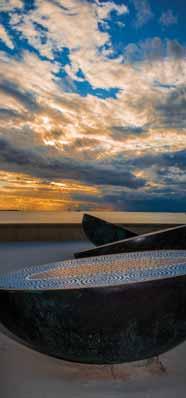
23. STIRLINGS ARTWORKS
by Naomi Danischewsky, Kevin Eastaugh, Rose Holdaway, Janeen Horne, Marianne Penberthy, Peta Riley, 2013 Geraldton’s Stirlings Shopping Centre partnered with local artists to create billboard-scaled images based on natural elements earth, air, water and fire, and mounted atop the Centre’s walkway.
24. MONSIGNOR JOHN CYRIL HAWES AND HIS DOG DOMINIE
by Joan Walsh-Smith and Charles Smith, 2016
Serving as the starting point for a visit to the Monsignor Hawes Heritage Centre, this sculpture represents the astonishing character and fascinating passions of this remarkable priest-architect, and his faithful friend, Dominie.
25. WIND SAILS
by Edmund Steward and Judy Chapman-Hebb, initiated by Main Roads, 2006
Welcoming you to Geraldton from the south and on a section of highway know as Mahomets’ overpass, three upright sails stand over eight metres high and change their orientation with the ever-present wind direction.
26. MAHOMETS MURAL
by Phil Doncon, 2020
In an area named after Abdullah Mahomet, a market gardener who lived here in the 1860s, this massive mural brings together historical, contemporary and multicultural local stories.
27. OLIVE STREET WORLD WAR I MEMORIAL by Bruce Sherwood, 2018
The devastation of World War is symbolised by sculptural poles representing the stark battlefield and burnt trees of the Ypres Salient, 1916.
28. MEMORIAL SUNDIAL WING
by William (Bill) Newbold and Mark Cannon (Engineer), 2008
This sundial honours World War II service men and women stationed at the No. 4 Service Flying Training School, housed at the Geraldton Aerodrome from 1941-1944. The sculpture is a life-size replica of an Avro Anson aircraft wing.

29. GRAMS PARK
Concept design by George Domahidy and Pavel Perina, 2021
The site-specific elements of a welcoming archway, water tank with mural, waterplay elements and a pathway to a basketball half court are united by the theme of a dreaming pathway and watercourse as advised by Aboriginal elders working closely with Champion Bay Senior High School students.
PUBLIC ART IN MULLEWA
30. EVERLASTING IMPRESSIONS
by Eliza Thompson and Peter James, 2017
On the drive into Mullewa along the Geraldton - Mt Magnet Road, the Everlasting Impressions sculpture sits to the left, welcoming you to Wildflower Country and depicting the Midwest’s ever-popular paper daisy.
31. THE MULLEWA ENTRANCE MURAL
Callaghan Park by Helen Ansell, Charmaine Green, Susan Merry, Pauline Bell and Debra Maher, 2022 Representing Mullewa’s heritage as an important Aboriginal centre and as an entry to Wildflower Country, the mural also acknowledges the former role of the railway head in Mullewa. The patterns emphasise the connectedness of the Mullewa community, celebrated with an array of wildflowers from the region.
32. MONSIGNOR HAWES PATHWAY concept design unknown, 2019
This elegant pathway details the life and significant works of the priest-architect Monsignor John Hawes who designed and built many inspirational churches and buildings in the Midwest, Gascoyne and Murchison from 1915 to 1939. The pathway features a number of mosaics created by local Wajarri artists.
33. SKATE PARK MURAL by Shah Jackey, 2018
Painted by local Geraldton Artist Shah Jackey and local youths, the concrete curves of the skate park depict local fauna found in the




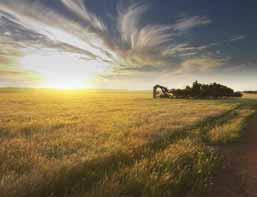
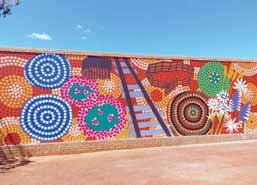
Aboriginal artist Georgina Brown. The mural is part of a coordinated initiative, with community gardens, an outdoor cinema, a firepit and recycled metal sculptures around the Police Station.
The mosaic was designed as a community project to memorialise 125 years since Mullewa was officially gazetted as a Municipality on 3 April 1895. Mullewa is home to a rich Indigenous history and played a vital role in the opening up of the pastoral and goldbearing country across the Murchison.
38. MULLEWA ANZAC PRINTED MURAL initiated by the Shire of Mullewa, 2012 The Mural is placed on an exposed brick wall as a backdrop to the Mullewa War Memorial, reminding us of the sacrifice by our servicemen and women.
39. MULLEWA CARAVAN PARK MURAL by Helen Ansell, 2018
This Wreath Flower Artwork was commissioned by the City to be displayed in the Mullewa Caravan Park for the visitors during the Wildflower Season who often come from all over the world to visit these spectacular flowers. Known for their unusual and striking pink, yellow and red colours, these flowers grow in a ring and when viewed from above has a wreath like form during its flowering period around August to November.
40. ST ANDREWS CHURCH by Helen Ansell, 2021
This mural was commissioned by the Anglican Church in celebration of its 100th anniversary. The mural depicts Jesus’ parable of the Sower and the seed in the setting of local wildflowers.
41. OLMC SCHOOL MURAL by Helen Ansell, 2020
Based on the theme of “The Fruits of the Spirit” which incorporates the school’s values. The plant depicted is a local bush fruit - the “Bush Tomato” (or Flannel Bush) Solanum lasiophyllum and inside each fruit are written the words love, joy, peace, goodness, kindness, gentleness and self-control.
42. HELEN ANSELL STUDIO GALLERY MURAL by Helen Ansell, 2021 “Desert Gold” - a second in Helen Ansell’s series of carpets of Wildflowers based upon the original “Desert Bloom”, these are a series of flowers that grow specifically to the area of her hometown of Mullewa.
PUBLIC ART IN GREENOUGH
43. ELLENDALE POOL 2013
The story of Bimarra Serpent, the creation of the Greenough River and the serpent’s resting place at Ellendale Pool is told through information panels and a steel sculpture, sharing this significant Aboriginal story and site.
44. LEANING TREES OF GREENOUGH Nature’s own artistic interpretation of the windswept Greenough Flats. Prior to colonisation the area around Greenough was well watered by freshwater springs, pools and soaks. Here you’ll find Eucalyptus camaldulensis or the Red River Gum, growing perpendicular to the soil due to the air’s salt content and the characteristic strong, southerly winds blowing off the Indian Ocean. See more examples of local trees at the Greenough Museum and Gardens, and the Central Greenough Historic Settlement.
Location: Art Gallery Park
Typology: Sculptures
Scope: Small to Medium Scale
Opportunities include: To increase public amenity and encourage visitors to use the Art Gallery Park. Potential for interactive elements
Curatorial themes: Animals, Indigenous connection to natural environment, City of Greater Geraldton, Community, wildflowers
Artwork objectives: To increase the vibrancy of the area and encourage positive behaviour land and property.
Process: EOI callout to artists and selection process
Challenges: The sculptures would need to be durable and securely in the ground to prevent theft
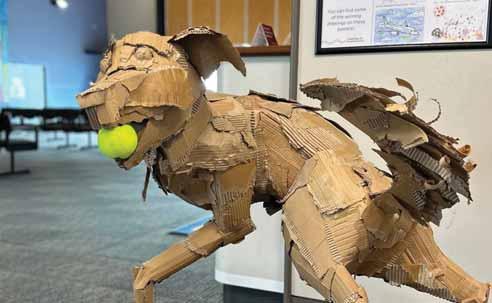
Location: Geraldton CBD
Typology: Community art. Opportunity for light or projection installations
Scope: Medium Scale
Opportunities: Increasing opportunity for local/ Midwest ephemeral public art. Strengthen the vibrancy of the area with potential to encourage a new wave of public artists
Curatorial theme: City of Greater Geraldton, Community, sport, wildflowers, land and country
Artwork objectives: To increase the vibrancy of the area and encourage positive behaviour land and property. Offer more opportunities for local artists
Process: EOI callout to artists and selection process, community callout
Challenges: Artworks would need to be durable to survive the duration of the project

Location: Along Chapman Road, Marine Terrace, Foreshore Drive, and Beresford Foreshore areas. High foot traffic locations
Typology: Murals, Sculptures
Scope: Medium Scale
Opportunities: potentially two or three works in key locations along the Foreshore, bringing together the artwork trail. There are currently a variety of sculptures and murals along this area
Potentially use external artists
Curatorial theme: City, Port link, ocean themes
Artwork objectives: to increase the vibrancy of the Foreshore, a highly visited tourist drawcard
Process: EOI callout and selection process
Challenges: there are currently a range of artworks along the Foreshore, the new works should be standalone pieces that all sit together in an artwork trail
Location: Cape Burney, car park lookout area
Typology: Sculpture
Scope: Large scale
Opportunities: a large-scale sculptural statement for Cape Burney, encouraging visitors and locals alike to stop and capture the sculpture with the winding rivermouth in the background. This should become an iconic artwork, drawing people to the location
Curatorial theme: perseverance, history and coastal themes
Artwork objectives: to celebrate Cape Burney and its tourism potential, creating an iconic artwork that draws crowds
Process: external opportunity, with EOI and Concept Design process
Challenges: this will be a large scale public art project and would require a well-recognised artist to create the artwork, increasing the value of the Public Art Collection


Location: Along Gordon Garratt Drive, leading to the Geraldton Airport or within building redevelopment
Typology: Sculpture, Lighting, Digital
Scope: Medium to Large Scale
Opportunities: Activating the area with a fun sculpture. Increasing the vibrancy of the route to the airport
Curatorial theme: Aviation, City of Greater Geraldton, Paper planes
Artwork objectives: To increase the vibrancy of the area
Process: EOI callout to artists and selection process, community callout
Challenges: Finding a suitable location amongst the industrial landscape

Location: Ephemeral/Trail
Scope: Small – medium scale
Opportunities:
• An ephemeral seasonal public art trail throughout the City, including outlying areas
• A series of temporary sculptures, murals or play-based artworks located in various locations to form a driving trail
• Creating paid opportunities for local artists
• To run the activity over the popular wildflower season
• Creation of art to represent our region and provide a tourist destination
Curatorial theme: Can have relation to all curatorial themes
Artwork Objectives:
• Bringing more people to the region to discover the creativity of local artists
• Provide local artists the opportunity to display their work in the public realm and encourage emerging local artists to expand their creative portfolio
Process: EOI callout and selection process
Challenges: Artworks will only need to be temporary but will still need to be durable enough to withstand environmental elements e.g. rain, wind for the duration of the wildflower season, safe access

Location: Various murals across the City
Typology: Murals
Scope: Medium to large scale
Opportunities: Potential for community engagement project, led by an artist/artist group. Encouraging the community to come together and invest in their city, bringing more colour and light to the area, extend the life cycle of existing artworks with the opportunity to address and ease anti-social behaviour, place-making
Curatorial theme: City of Greater Geraldton, Community, sport, land and country etc
Artwork objectives: To increase the vibrancy of the area and encourage positive behaviour with land and property
Process: EOI callout to artists and selection process, community callout
Challenges: Mural sizes, multiple artists may be required, safety and logistical concerns

Location: Throughout City of Greater Geraldton, various locations
Typology: Murals
Scope: Small Scale
Opportunities: Across the City there are a number of public ablution blocks that could have community murals painted, workshops in schools, integrated designs, or alternative designs to activate the spaces and become a feature. Potentially use a mix of local, and external artists, as well as school and community groups
Curatorial theme: Various themes based on the locations of the ablution blocks
Artwork objectives: To create spaces that the community can have pride in and celebrate, counteract vandalism
Process: Mixture of direct approach, community processes, and EOIs
Challenges: There are a number of ablution blocks around the City that are facing increased vandalism and anti-social behaviour, creating a need for a different approach to activating spaces and creating more community ownership

Public Space Structures
Location: Across the City of Greater Geraldton
Typology: Functional
Scope: Small, Medium and Large scale
Opportunities:
• Artist-designed shade structures installed at the main parks in the CBD
• Potential to use the natural elements of sun and shadow through the functional shade structures to create artwork effects on the footpath
• Seating
• Lighting installations
• Kinetic installations which are also playful
• Bicycle racks
• Bus Shelters
Curatorial themes: Related to the geographical area - Stories of the City
/ The Threshold / The Hinterland



Public Art in communities can pose a number of challenges. Below is a breakdown of some of the challenges faced, and the potential mitigating factors for these:
• Community dissent and dissatisfaction with public art projects
- Organise artist-led community art projects to give the surrounding community a stronger sense of involvement
- Provide more information on the processes surrounding public art commissioning and management
- Involve community stakeholders in the process from the initial stages where appropriate
• Vandalism and artwork damage
- Continue to budget for anti-graffiti coats, protective surfaces, consider materials
- Encourage community to take pride in the public art
• Local artists
- More education is needed around having a diverse Public Art Collection, showing the community the benefit of using a mix of local and external artists
- Currently, there are not enough local artists working in public art, creating a need to look further abroad, benefiting the town by bringing in recognisable artists


Ownership of the artwork is dependent on the commissioning process, contract and the land it is located in. In most cases, the contract with the artist/s identifies the artwork to be owned by the commissioning body once the artwork is installed and final invoices paid. Artwork located on private land is owned and maintained by the landowner. Artwork located on public land is owned and maintained by the City of Greater Geraldton unless arranged otherwise.
Artworks have differing maintenance requirements to ensure safety, longevity and visual amenity. The longevity of the work should be in accordance with the intent of the artwork. Upon installation of the artwork, it is important that the owner obtains the information below to assist in maintenance requirements. These include:
• Agreement of ownership and maintenance responsibilities, particularly stating the timeline for handover
• The expected lifespan of the artwork and any of its components
• Detailed maintenance manual:
- Artwork title
- Artist/artist group name and contact details (ensure there are multiple forms of contacts)
- Description of the artwork
- If relevant, fabricated works may have the subcontractors and fabricators with contact details listed
• Any on-going maintenance required set out in a program, with recommended timelines and estimated costs associated with this


The City will have the right to reproduce extracts from the design documentation from the concept design of the Public Art and photographic images of the Public Art for non-commercial purposes, such as annual reports, information brochures, social media and information on the City website, and wording to this effect must be included in any Artist Contracts.
Australia Copyright Law requires all original Public Art to be attributed to the artist. Artists are to be acknowledged when images of their work are published. A didactic plaque must be installed next to the artwork/s to acknowledge the artist. The didactic plaque will include the following:
• Title of work
• Artist’s name
• Year of artwork commission
• An Artist Statement may be appropriate to include, assisting the public to understand and interpret the work
• If relevant, details of any funding
• City of Greater Geraldton logo
• Logos for any partner organisation or funding bodies
On occasion, artwork may be accompanied by an interpretive sign, rather than plaque. In this instance, at a minimum the above information should still be included.
Artworks should only be modified for conservation or restoration reasons. The artist must be consulted prior to any works taking place. Reasonable steps must be taken to contact the artist ahead of any relocation, sale, removal or destruction of any works.


Deaccession, disposal and repurposing of Public Art may be considered subject to the following:
• The relevance of the artwork within the objectives and criteria of the Public Art Masterplan and Public Art Strategy
• If maintenance and repair becomes excessive
• If the artwork is in poor condition, damaged or deteriorating beyond reasonable repair
• The artwork poses a risk to public safety
• If it has been in storage for more than three years
• The use of the public space has been changed
Strategy

Artworks that have been identified for deaccession must be fully documents prior to disposal or repurposing. The artworks’ lifespan must be documented through the maintenance report updated periodically through internally-led public art audits.
In these circumstances, the artwork will be offered back to the artist or donor. If they do not wish to take back the artwork, they artwork may be disposed of following the City’s Disposal process.
Artwork credit: 1. ‘Baby Orange’, Helen Ansell. 2. ‘Northside’, Naomi Danischewsky. 3. ‘Where the leaves fall’, Janeen Horne.






